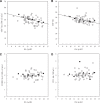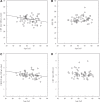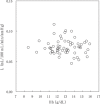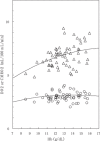Interindividual variations of cerebral blood flow, oxygen delivery, and metabolism in relation to hemoglobin concentration measured by positron emission tomography in humans
- PMID: 20160738
- PMCID: PMC2949226
- DOI: 10.1038/jcbfm.2010.13
Interindividual variations of cerebral blood flow, oxygen delivery, and metabolism in relation to hemoglobin concentration measured by positron emission tomography in humans
Abstract
Regional cerebral blood flow (CBF) and oxygen metabolism can be measured by positron emission tomography (PET) with (15)O-labeled compounds. Hemoglobin (Hb) concentration of blood, a primary determinant of arterial oxygen content (C(a)O(2)), influences cerebral circulation. We investigated interindividual variations of CBF, cerebral blood volume (CBV), oxygen extraction fraction (OEF), and cerebral metabolic rate of oxygen (CMRO(2)) in relation to Hb concentration in healthy human volunteers (n=17) and in patients with unilateral steno-occlusive disease (n=44). For the patients, data obtained only from the contralateral hemisphere (normal side) were analyzed. The CBF and OEF were inversely correlated with Hb concentration, but CMRO(2) was independent of Hb concentration. Oxygen delivery defined as a product of C(a)O(2) and CBF (C(a)O(2) CBF) increased with a rise of Hb concentration. The analysis with a simple oxygen model showed that oxygen diffusion parameter (L) was constant over the range of Hb concentration, indicating that a homeostatic mechanism controlling CBF is necessary to maintain CMRO(2). The current findings provide important knowledge to understand the control mechanism of cerebral circulation and to interpret the (15)O PET data in clinical practice.
Figures





Similar articles
-
Separation of input function for rapid measurement of quantitative CMRO2 and CBF in a single PET scan with a dual tracer administration method.Phys Med Biol. 2007 Apr 7;52(7):1893-908. doi: 10.1088/0031-9155/52/7/009. Epub 2007 Mar 12. Phys Med Biol. 2007. PMID: 17374918
-
Day-to-day test-retest variability of CBF, CMRO2, and OEF measurements using dynamic 15O PET studies.Mol Imaging Biol. 2011 Aug;13(4):759-68. doi: 10.1007/s11307-010-0382-1. Mol Imaging Biol. 2011. PMID: 20700768 Free PMC article. Clinical Trial.
-
Database of normal human cerebral blood flow, cerebral blood volume, cerebral oxygen extraction fraction and cerebral metabolic rate of oxygen measured by positron emission tomography with 15O-labelled carbon dioxide or water, carbon monoxide and oxygen: a multicentre study in Japan.Eur J Nucl Med Mol Imaging. 2004 May;31(5):635-43. doi: 10.1007/s00259-003-1430-8. Epub 2004 Jan 17. Eur J Nucl Med Mol Imaging. 2004. PMID: 14730405 Clinical Trial.
-
Human cerebral circulation: positron emission tomography studies.Ann Nucl Med. 2005 Apr;19(2):65-74. doi: 10.1007/BF03027383. Ann Nucl Med. 2005. PMID: 15909484 Review.
-
In-vivo positron emission tomography (PET) measurement of cerebral oxygen metabolism in small animals.Yakugaku Zasshi. 2008 Sep;128(9):1267-73. doi: 10.1248/yakushi.128.1267. Yakugaku Zasshi. 2008. PMID: 18758140 Review.
Cited by
-
Changes in volumetric and metabolic parameters relate to differences in exposure to sub-concussive head impacts.J Cereb Blood Flow Metab. 2020 Jul;40(7):1453-1467. doi: 10.1177/0271678X19862861. Epub 2019 Jul 15. J Cereb Blood Flow Metab. 2020. PMID: 31307284 Free PMC article.
-
Components of day-to-day variability of cerebral perfusion measurements - Analysis of phase contrast mapping magnetic resonance imaging measurements in healthy volunteers.PLoS One. 2018 Jun 7;13(6):e0197807. doi: 10.1371/journal.pone.0197807. eCollection 2018. PLoS One. 2018. PMID: 29879126 Free PMC article.
-
Exploring the Impact of Hemoglobin on Cerebral Blood Flow in Arterial Territories and Surgical Outcomes: Potential Implications for Moyamoya Disease Treatment.J Am Heart Assoc. 2024 Oct;13(19):e035387. doi: 10.1161/JAHA.124.035387. Epub 2024 Sep 30. J Am Heart Assoc. 2024. PMID: 39344645 Free PMC article.
-
A frequency-domain machine learning method for dual-calibrated fMRI mapping of oxygen extraction fraction (OEF) and cerebral metabolic rate of oxygen consumption (CMRO2).Front Artif Intell. 2020 Mar 31;3:12. doi: 10.3389/frai.2020.00012. Front Artif Intell. 2020. PMID: 32885165 Free PMC article.
-
Cerebral oxygen metabolic stress is increased in children with sickle cell anemia compared to anemic controls.Am J Hematol. 2022 Jun 1;97(6):682-690. doi: 10.1002/ajh.26485. Epub 2022 Feb 14. Am J Hematol. 2022. PMID: 35113471 Free PMC article.
References
-
- Brown MM, Marshall J. Regulation of cerebral blood flow in response to changes in blood viscosity. Lancet. 1985;1:604–609. - PubMed
-
- Brown MM, Wade JP, Marshall J. Fundamental importance of arterial oxygen content in the regulation of cerebral blood flow in man. Brain. 1985;108 (Pt 1:81–93. - PubMed
-
- Buxton RB, Frank LR. A model for the coupling between cerebral blood flow and oxygen metabolism during neural stimulation. J Cereb Blood Flow Metab. 1997;17:64–72. - PubMed
-
- Frackowiak RS, Lenzi GL, Jones T, Heather JD. Quantitative measurement of regional cerebral blood flow and oxygen metabolism in man using 15O and positron emission tomography: theory, procedure, and normal values. J Comput Assist Tomogr. 1980;4:727–736. - PubMed
-
- Gjedde A, Poulsen PH, Ostergaard L. On the oxygenation of hemoglobin in the human brain. Adv Exp Med Biol. 1999;471:67–81. - PubMed
MeSH terms
Substances
LinkOut - more resources
Full Text Sources

